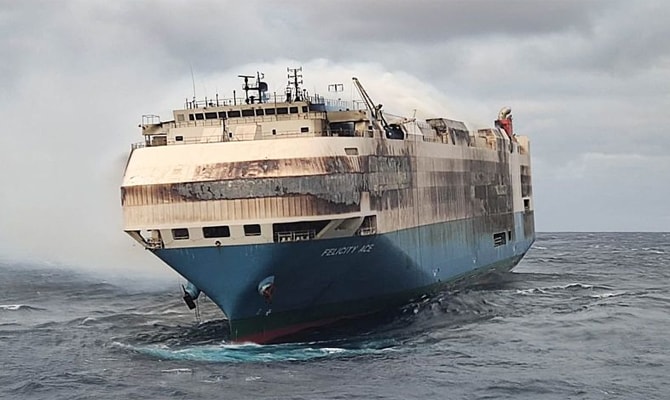More than $400 million worth of cargo — including high-end luxury vehicles like Porsches, Bentleys, and Lamborghinis — sank to the bottom of the Atlantic Ocean on the Felicity Ace after a two-week long fire onboard.
Luckily, all 22 crew members safely evacuated beforehand with help from the Portuguese Air Force. However, the cargo was a total loss, with a staggering 4,000 vehicles going down with the 656-foot-long cargo ship.
This story really caught the attention of the mainstream media, bringing yet another harsh spotlight on disasters within the maritime industry. On the positive side, Allianz Insurance reports only 49 total losses in 2020, a 50% decline over the past decade.
However, the causes and types of losses have changed. Sinkings (54%), wrecks (20%), and fires (11%) represent the top three causes of total loss for shipping companies over the last decade. Fires like the Felicity Ace are, in fact, on the rise.
But the question remains: Could this ship disaster, and others like it, have been prevented?
What Caused the Felicity Ace Disaster
The short answer? We may never know for sure.
Here’s what we know: The Panama-flagged cargo carrier owned by Japanese company MOL Ship Management (Singapore) had been on a routine run from Germany to the United States off the coast of the Portuguese Azores Islands on February 16, 2022, when fire broke out on board. After launching a distress signal and initiating crewmember evacuation, the ship remained adrift for several weeks until finally sinking on March 1.

“The ship is burning from one end to the other…everything is on fire about five meters above the water line.” — Captain Joao Mendes Cabecas, to Reuters
Several experts point to the existence of lithium ion batteries and electric batteries with the cargo as a possible source of the fire. Regardless of the source, these highly flammable items, once ablaze, require specialized equipment to extinguish and can burn uncontrollably for long periods of time. At this time, though, it’s not clear exactly whether the batteries themselves caused the fire, or if the nature of the cargo made it impossible to contain the blaze.
Onboard Fires Remain Major Safety Hazard
Onboard fires remain one of the biggest hazards for today’s shipping industry. The number of fires resulting in total losses of vessels continues to increase year over year, with Allianz reporting a four-year high of 10 incidents in 2020 alone.
“Firefighting capabilities on board have not kept up with the upsizing of container vessels, to ensure the preservation of the vessel itself. This is one of the most significant safety issues on board this type of vessel and there needs to be considerable development to protect container ships in the event of fire.” — Chris Turberville, Head of Marine Hull & Liabilities, UK, AGCS.
As ships grow larger — increasing by 1500% over the last fifty years — firefighting becomes more difficult, especially because of a major time lag between ship-to-shore emergency communication and dispatching. While the Felicity Ace was only 90 nautical miles away from shore, which facilitated relatively quick response times for both firefighting efforts and evacuating crew members, other ships aren’t always that lucky.
The Felicity Ace fire lasted a full two weeks before the vessel sank around 220nm off the Azores, resulting in a total loss and major insurance claims for the shipowners.
How Technology Can Prevent Future Ship Disasters
Major ship disasters like the Felicity Ace in March 2022, the Ever Given in February 2021, and the Madrid Bridge in January 2022 continue to make headlines. Without visibility into ship operations — and with ships languishing at the bottom of the ocean — there’s no real way to know exactly what happened.
That’s exactly why we created FleetVision™ at ShipIn. In an emergency scenario like this one, ShipIn’s network of AI-powered cameras would have detected smoke on the cargo deck immediately, alerting both the bridge and management on shore and automatically starting evacuation and emergency protocols, saving precious minutes for both safety of crew and cargo.
While there’s no way to know if this early detection could have contained the fire more quickly, FleetVision™ would absolutely give your team an understanding of the events leading up to the event, such as missed routine maintenance, security breaches, or navigational factors.
With ShipIn, you get the visibility and insights you need to effectively manage your fleet, keeping your ship operations safe and secure.


